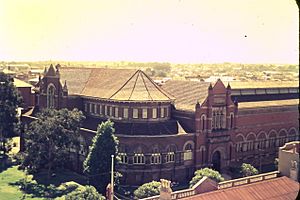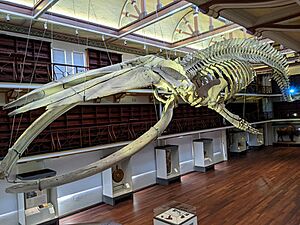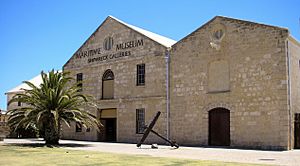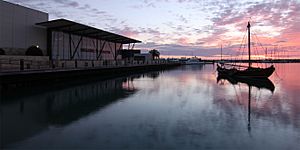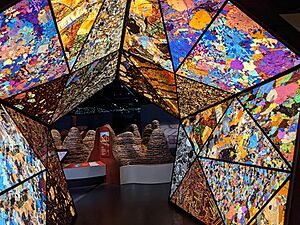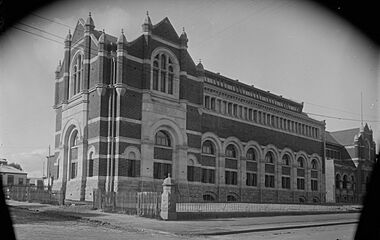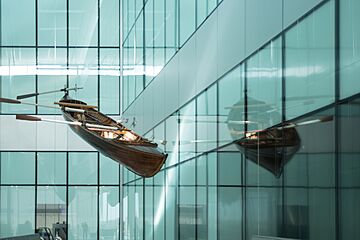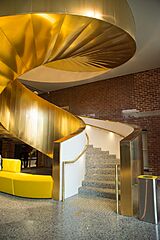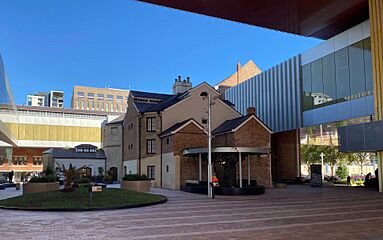Western Australian Museum facts for kids
 |
|
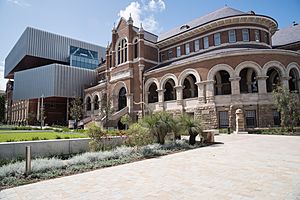
WA Museum Boola Bardip in 2020
|
|
| Established | 1891 |
|---|---|
| Location | Perth, Fremantle, Albany, Geraldton, Kalgoorlie-Boulder |
| Collection size | 8,233,264 |
| Visitors | 971,528 (2021) |
The Western Australian Museum is a super cool place to explore and learn! It's like a giant treasure chest filled with amazing stories about Western Australia's past, its incredible nature, and its diverse cultures.
The museum has six main locations where you can discover different things. The biggest one, called WA Museum Boola Bardip, is in Perth. The other exciting spots are the WA Maritime Museum and WA Shipwrecks Museum in Fremantle, the Museum of the Great Southern in Albany, the Museum of Geraldton in Geraldton, and the Museum of the Goldfields in Kalgoorlie-Boulder.
Contents
History of the Museum
The Western Australian Museum first opened its doors in 1891. It started in the Old Perth Gaol and was first known as the Geological Museum. Back then, it mainly showed off rocks and minerals.
Soon after, in 1892, the museum added exhibits about different cultures and animals. By 1897, it officially became the Western Australian Museum and Art Gallery. The museum even hired people to travel across the state to collect animals and tools from the local Aboriginal people.
In 1959, the museum's plant collection moved to a new place. The museum and the art gallery then became separate, focusing on different things. The museum started to concentrate on natural sciences, human history, old discoveries, and Western Australia's past. It also began to study historic shipwrecks and manage important Aboriginal sites.
In 2012, the government decided to build a brand new museum in the Perth Cultural Centre. The old Perth museum site closed in June 2016 to make way for this exciting new building.
While the new museum was being built, important improvements were made to the museum's Collection and Research Centre (CRC) in Welshpool. This is where the museum keeps its research labs and many of its collections. The upgrades helped create new storage, labs, and workshops to support ongoing research and keep the collections safe.
Museum Locations
The Western Australian Museum has six different museum branches. It also has special places where it keeps its collections and offers programs to people all over Western Australia.
Perth Museum
The Old Museum Building
The first museum opened in Perth on September 9, 1891. It was called the Geological Museum and was located in the Old Gaol. This Old Gaol building is still a big part of the Western Australian Museum in Perth today. It's one of the oldest buildings standing in Western Australia!
After the Geological Museum opened, its collections grew to include rocks, cultural items, and animals. In 1897, it became the Western Australian Museum and Art Gallery. For many years, the museum's main location on James Street was a central spot for big exhibits. These shows covered fashion, natural history, and cultural heritage.
Some of the cool permanent exhibits at the old Perth museum included:
- WA Land and People: This exhibit told the story of Western Australia from ancient times with dinosaurs, through Aboriginal beginnings, to today's environmental topics.
- Diamonds to Dinosaurs: This show explored 12 billion years of WA's history. It featured amazing items like rocks from the Moon and Mars, tiny diamonds older than the sun, and dinosaur skeletons.
- Katta Djinoong: This exhibit showed the history and culture of the Aboriginal peoples of Western Australia.
- Dampier Marine Gallery: This exhibit explored the amazing sea life around the Dampier Archipelago.
- Mammal, Bird and Butterfly Galleries: These galleries had huge collections of different animals.
The Perth museum closed in June 2016 for a big makeover.
The New Museum: Boola Bardip
After four years of building, the new Perth museum re-opened on Saturday, November 21, 2020. The new museum is called WA Museum Boola Bardip. It has exciting new exhibits and topics. You can learn about how the Universe formed, WA's newest inventions, dinosaurs, newly found species, and local communities.
Inside the new museum, there are five old heritage buildings, including the Old Perth Gaol from 1855. The museum is also built around what might be Australia's oldest grapevine, which is thought to be from the 1850s or 1860s. The museum also includes Hackett Hall, which used to be a library. Now, it displays the huge skeleton of a blue whale named Otto! The Jubilee Building has also been updated, with its grand entrance now open again.
Maritime and Shipwrecks Museums
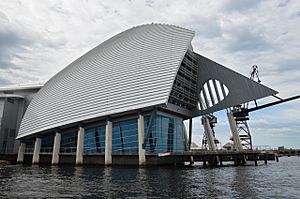
The Western Australian Museum has two branches in Fremantle: the WA Maritime Museum and the WA Shipwrecks Museum.
The WA Maritime Museum is located on Victoria Quay. It has galleries about the Indian Ocean, the Swan River, fishing, maritime trade, and naval defense. One of the most famous items in the museum is the yacht Australia II. This yacht won the America's Cup in 1983! The museum is in a very important historical area by the water.
Right next to the WA Maritime Museum, you can see HMAS Ovens. This is a real Oberon-class submarine that you can take a guided tour inside! It reminds us of the World War II submarine base in Fremantle. This base was the biggest submarine base in the southern hemisphere during the war.
Nearby, on Cliff Street, is the WA Shipwrecks Museum. It's in old buildings from the 1850s. This museum is known as one of the best places in the southern hemisphere for learning about maritime archaeology and saving shipwrecks. The museum has a rebuilt part of the hull from the Dutch East India Company ship Batavia. This ship was wrecked off Western Australia's coast in 1629. You can also see many other items from ships that sank along the WA coast.
Museum of the Great Southern
The Museum of the Great Southern was updated in July 2010. It is located in Albany, where the first Europeans settled in Western Australia. This museum explores the region's amazing plants and animals, the stories of the local Noongar people, and the ancient natural environment.
The museum building was once the home of Major Edmund Lockyer. He was the leader of the group that landed in Princess Royal Harbour on December 26, 1826. They officially claimed the land for King George IV of Great Britain on January 21, 1827.
Museum of Geraldton
The Museum of Geraldton is in Western Australia's growing mid-west region. This museum explores the region's plants and animals, its history of mining and farming, the stories of the local Yamaji people, and the Dutch shipwrecks. The famous 17th-century Dutch ship Batavia sank near the Abrolhos Islands. This museum has a special part of the ship, called a portico, that was recovered from the wreck. It has been put back together and is a main feature of the museum's shipwreck gallery.
Museum of the Goldfields
The Museum of the Goldfields in Kalgoorlie-Boulder explores the history of the Eastern Goldfields. It tells the story of the city's mining past and the challenges faced by the early miners and pioneer families.
Museum Research
The Western Australian Museum has a big research program. Museum scientists and experts study many different areas. These include water animals, old discoveries, human cultures, how to keep things safe, earth and planetary sciences, history, and land animals. The museum also has a special team that works on keeping materials safe.
Most of the museum's collections and research facilities are at the WA Museum Collections and Research Centre (CRC) in Welshpool. Here are some of the departments there:
- The Terrestrial Zoology department studies and keeps large collections of many different land animals. This includes insects, birds, mammals, spiders, and reptiles.
- The Aquatic Zoology department studies and records the animals that live in the ocean, rivers, and fresh water in Western Australia. This includes snails, fish, crabs, and other sea creatures.
- The Earth and Planetary Sciences Department studies and collects fossils (from animals, plants, and traces), minerals, rocks, gems, and meteorites. This department's collection shows the history of life and geology in Western Australia from 3.8 billion years ago! There are over 1.5 million items in this collection.
- The History Department collects items that show what life was like for people in Western Australia. They research the stories of people and places across the state.
- The Anthropology and Archaeology Department studies human cultures and old discoveries. They focus on understanding what it means to be human, cultural differences, and how society, culture, language, and economy are connected. They also study Ancient Egypt and Aboriginal cultures.
Some items from the Maritime Archaeology and Maritime History departments are also kept at the CRC. However, the staff from these departments work at the WA Shipwrecks Museum.
The Materials Conservation department makes sure that the millions of items in the museum's collections are kept safe forever. They use special techniques to preserve them for research and exhibitions. This department also does research to find new ways to keep things safe.
Gallery
See also


